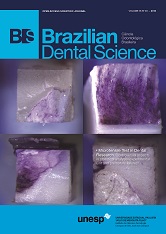Microtensile test in dental research. controversial aspects in statistical analysis (experimental unit and premature failures)
DOI:
https://doi.org/10.14295/bds.2013.v16i3.869Abstract
Aims: The aim of this study was to present the controversial aspects in performing inferential statistical analysis with regard to selection of the experimental unit and procedures adopted in the case of pre-test failures.
Material and Method: Eighty-seven dissertations and theses in the field of dentistry were evaluated, in which microtensile testing available at three public Universities in the State of São Paulo were performed, namely: School of Dentistry, USP; School of Dentistry, Unesp (Araraquara and São José dos Campos) and the Piracicaba School of Dentistry (Unicamp).
Results: As regards the experimental unit, 34 (39.08%) theses and/or dissertations used the “stick” and 53 (60.91%) the “tooth/block” type. With regard to pre-test failures, 9 (10.34%) theses and/or dissertations attributed the value “0”, 6 (6.89%) disregarded the sticks, 2 (2.29%) attributed the minimum value of 2 MPa, 1 (1,14%) the minimum value of 4 MPa, 1 (1.14%) attributed half the minimum value of the group and 68 (78.16%) did not mention the occurrence of pre-test failures.
Conclusion: As regards the experimental unit, at present the experimental unit is considered the tooth (or ceramic bloc) and not the stick. With regard to pre-test failures, the following are considered: Attribution of a minimum bond strength value under the experimental condition or in the group considered; expressing the number and percentage of cases of failures under each experimental condition; which failures were included in the statistical analysis and making a comparison between the analysis with exclusion of the sticks and analysis without inclusion of the sticks.
Downloads
Downloads
Published
How to Cite
Issue
Section
License
Brazilian Dental Science uses the Creative Commons (CC-BY 4.0) license, thus preserving the integrity of articles in an open access environment. The journal allows the author to retain publishing rights without restrictions.
=================




























